Sambor Prei Kuk
| Sambor Prei Kuk ប្រាសាទសំបូរព្រៃគុក Isanapura (old name) ឦសានបុរៈ | |
|---|---|
| Archaeological Park | |
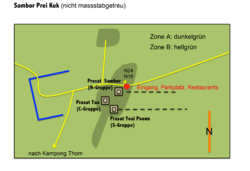 Map of Sambor Prei Kuk temple site | |
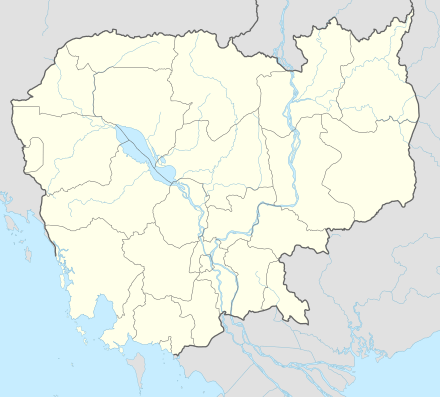 Sambor Prei Kuk Location within Cambodia | |
| Coordinates: 12°52′15″N 105°2′35″E / 12.87083°N 105.04306°ECoordinates: 12°52′15″N 105°2′35″E / 12.87083°N 105.04306°E | |
| Country | Cambodia |
| Province | Kampong Thom |
| District | Prasat Sambor |
| Commune | Sambor |
| Village | Sambor |
| Founded by | Isanavarman I |
| Time zone | UTC+07:00 (UTC Kampong Thom) |
| Nearest city | Kampong Thom City |
| Official name | Sambor Prei Kuk temple site |
| Type | Cultural |
| Criteria | ii, iii, vi |
| Designated | 2017 (41st session) |
| Reference no. | 1532 |
| State Party | Cambodia |
| Region | Southeast Asia |
Sambor Prei Kuk (Khmer: ប្រាសាទសំបូរព្រៃគុក - Prasat Sambor Prei Kuk) is an archaeological site in Cambodia located in Kampong Thom Province, 30 km (19 mi) north of Kampong Thom, the provincial capital, 176 km (109 mi) east of Angkor and 206 km (128 mi) north of Phnom Penh. The now ruined complex dates back to the Pre-Angkorian Chenla Kingdom (late 6th to 9th century), established by king Isanavarman I as central royal sanctuary and capital, known then as Isanapura (Khmer: ឦសានបុរៈ - Isan borak).[1][2] In 2017, Sambor Prei Kuk was declared as a UNESCO World Heritage Site.[3]
Located on the Eastern bank of the Tonle Sap lake, close to the Sen River, the central part of Sambor Prei Kuk is divided into three main groups. Each group has a square layout surrounded by a brick wall. The structures of the overall archaeological area were constructed at variable times: the southern and north groups (7th century) by Isanavarman I, who is considered a possible founder of the city[4] and the central group (later date).
The buildings of Sambor Prei Kuk are characteristic of the Pre-Angkorean period with a simple external plan. The principal material is brick, but sandstone is also used for certain structures.[5] Architectural features include numerous prasats, octagonal towers, shiva lingams and yonis, ponds and reservoirs, and lion sculptures. Sambor Prei Kuk is located amidst mature sub-tropical forests with limited undergrowth. The area has been mined and could still contain unexploded ordnance.[6]
The Clusters
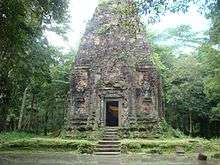
The whole compound is made of three clusters classified as group C for Central, N for North and S for South (Michon & Kalay, 2012).[7] They are enclosed in a double-walled encircling 1,000 acre in which there were 150 Hindu temples today mostly in ruins.
- Group N: Prasat Sambor (ប្រាសាទសំបូរ) is considered the main temple and it dates from the 7th century. It was dedicated to one of the reincarnations of Shiva known as Gambhireshvara (from Sanskrit गम्भीर - gambhir, profound, deep, solemn - and शिव, shvara, Shiva, Śiva, The Auspicious One).
- Group S: Prasat Yeah Puon (ប្រាសាទយាយព័ន្ធ) includes 22 sanctuaries dated from the 7th century (600 - 635 AD) during the reign of Isanavarman I in dedication to Shiva.[8]
- Group C: It is occupied by the Central Sanctuary or Prasat Boram (ប្រាសាទបុរាម) with lion sculptures that had inspired the popular name of Prasat Tao (The Lions' Temple). It is, however, the newest group dating the 9th century. The other main feature is the Tower of Ashram Issey, but there were also other constructions (18 temples) now in ruined (Palmer, 2011).[9]
History
7th century
Isanavarman I reigned over the Chenla Kingdom between 616 and 637 AD, taking Isanapura as his capital[10] and it is argued that he built the main temple Prasat Sambor (Group N), as there is an inscription on the site attributed to his reign and dated 13 September 627 AD.[11] The king is also known for sending his first embassy to the court of the Sui Dynasty in China (616-617). Chenla conquered different principalities in the Northwest of Cambodia after the end of the Chinese reign period yǒnghuī (永徽) (i. e. after 31 January 656), which previously (in 638/39) paid tribute to China.[12]
The last important king in Isanapura was Jayavarman I, whose death caused turmoil to the kingdom at the start of the 8th century, breaking it in many principalities and opening the way to a new time: Angkor. This site is also claimed as an early capital of Jayavarman II (O'Reilly & Jacques, 1990).[13]
20th century
After the Lon Nol's coup d'état to Prince Norodom Sihanouk in 1970, US President Richard Nixon ordered a secret bombing of Cambodia to fight the Khmer Rouge guerrillas and any influence of North Vietnam in the country. The US aircraft bombed positions inside the archaeological site, causing craters near the temples, while the guerrillas left several mines on the land that were cleared only in 2008.
This site was added to the UNESCO World Heritage Tentative List on January 1, 1992 in the Cultural category.
Official religion
The official religion at Sambor Prei Kuk city was Shaivism, one of the four most widely followed sects of Hinduism, which reveres the god Shiva as the Supreme Being and the Lingam (in Sanskrit लिङ्गं, liṅgaṃ, meaning "mark", "sign", or "inference") or Shiva linga representing Shiva to be worshiped in temples.[14] In Cambodia as it is in India, the lingam is a symbol of the energy and potential of god Shiva himself[15] and this phallic symbol is often represented with the Yoni (Sanskrit: योनि yoni, literally "vagina" or "womb"), symbol of goddess Shakti, female creative energy.[16]
Shaivism was the religion of Chenla (ca. 550 - ca. 800 AD), including elements of Hinduism, Buddhism and indigenous ancestor cults.[17] In the Sambor Prei Kuk temples, it is possible to contemplate stone inscriptions in both Sanskrit and Khmer, naming both Hindu and local ancestral deities with Shiva and several altars with the lingam.
Gallery
 Group C and Prasat Boram or Prasat Tao.
Group C and Prasat Boram or Prasat Tao. Map of the Clusters.
Map of the Clusters.- The two lions at Prasat Boram.
 Lintel from Sambo Prei Kuk at Guimet Museum, Paris.
Lintel from Sambo Prei Kuk at Guimet Museum, Paris..jpg) Yeai Poeun Temple.
Yeai Poeun Temple.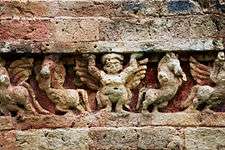 Temple N7.
Temple N7. Vajimukha (horse-headed deity) from temple N7 at the Guimet Museum.
Vajimukha (horse-headed deity) from temple N7 at the Guimet Museum. Temple S1.
Temple S1..jpg) S1 Yeai Poeun Temple
S1 Yeai Poeun Temple_en_2014.jpg) Prasat Boram
Prasat Boram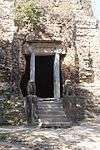 Prasat Boram S1 Sanctuary. Sambor Prei Kuk.
Prasat Boram S1 Sanctuary. Sambor Prei Kuk.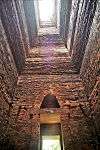 Interior Temple S1.
Interior Temple S1.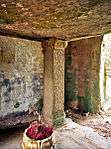 Interior Temple S1.
Interior Temple S1.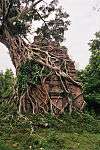 Temple N18.
Temple N18.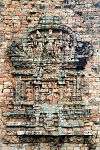 Temple N16.
Temple N16.
See also
Notes
- ↑ Higham, C., 2014, Early Mainland Southeast Asia, Bangkok: River Books Co., Ltd., ISBN 9786167339443
- ↑ Coedès, George (1968). Walter F. Vella, ed. The Indianized States of Southeast Asia. trans.Susan Brown Cowing. University of Hawaii Press. ISBN 978-0-8248-0368-1.
- ↑ "Sites in Cambodia, China and India added to UNESCO's World Heritage List". UNESCO. Retrieved 2017-07-08.
- ↑ Higham, Charles (May 11, 1989). The Archaeology of Mainland Southeast Asia. Cambridge University Press. pp. 265–267.
- ↑ Groupe de Sambor Prei Kuk - UNESCO World Heritage Centre
- ↑ Gnarfgnarf:Sambor Prei Kuk : a pre-Angkorian gem in the forest, 20 November 2010, retrieved on 3 May 2012
- ↑ Michon, D. & Kalay, Y. (2012). Virtual Sambor Prei Kuk: An Interactive Learning Tool. Systemics, Cybernetics and Informatics, 10 (3): pp. 29/37. Link retrieved on July 6, 2015 from http://www.iiis.org/CDs2011/CD2011SCI/EISTA_2011/PapersPdf/EA432ZU.pdf
- ↑ Description Prasat Yeah Puon. Ministry of Tourism of Cambodia. Link retrieved on July 8, 2015 from http://www.tourismcambodia.org/provincial_guide/index.php?view=attdetail&prv=6&att=280
- ↑ Palmer, B. The Rough Guide to Cambodia. August 1, 2011. p. 211. Link retrieved on July 6, 2015 from https://books.google.it/books?id=oR-Kmnj8wmAC&pg=PA211&dq=Sambor+Prei+Kuk&hl=en&sa=X&ei=0Y6aVZ-qAY_o8AWp-b6QDg&ved=0CD8Q6AEwBA#v=onepage&q=Sambor%20Prei%20Kuk&f=false
- ↑ “Coedès. ‟Histories of Cambodia”. Page 11.
- ↑ IC, Vol. V, p. 23
- ↑ Wolters, "North-western Cambodia in the seventh century", p. 356 and pp. 374-375
- ↑ O'Reilly. Early Civilizations of Southeast Asia. December 21, 2005. Page 113.
- ↑ Hinduism: Beliefs and Practices, by Jeanne Fowler, pgs. 42–43
- ↑ Mudaliyar, Sabaratna. "Lecture on the Shiva Linga". Malaysia Hindu Dharma Mamandram. Retrieved 27 March 2012.
- ↑ Zimmer, Heinrich Robert (1946). Campbell, Joseph, ed. Myths and symbols in Indian art and civilization. Princeton, New Jersey: Princeton University Press. p. 126. ISBN 0-691-01778-6. But the basic and most common object of worship in Shiva shrines is the phallus or lingam.
- ↑ Chandler, A History of Cambodia, pp.19-20.